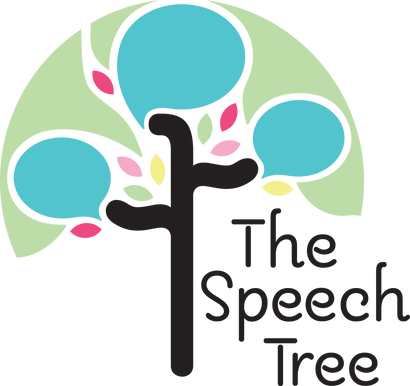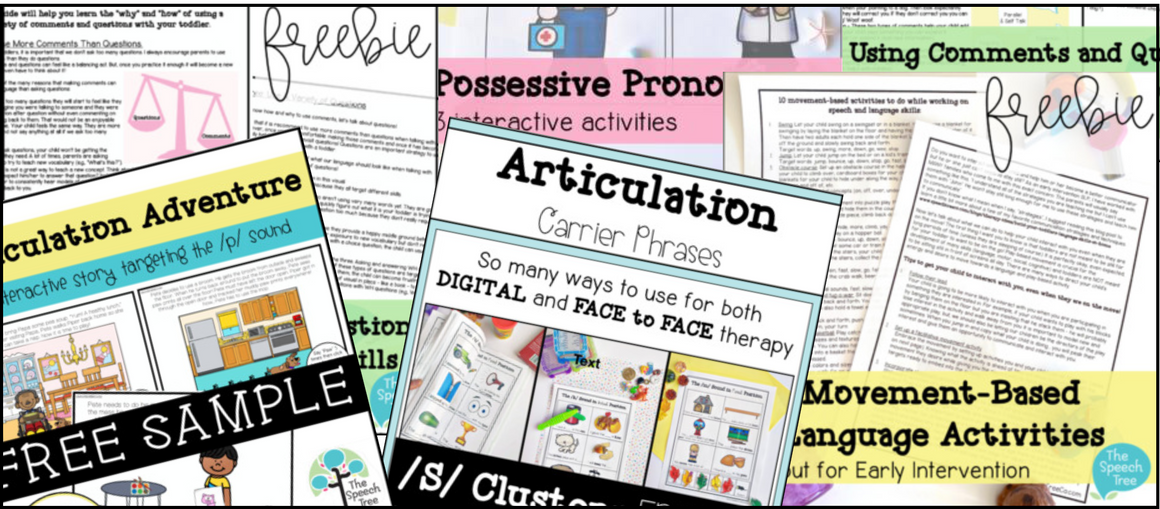Movement-Based Language Activities for the Active Toddler

*If you want to download this post in a printable handout format, you can do so by clicking HERE*
Do you want to interact with your child and help him or her become a better communicator but he or she just can’t seem to stay still? As an early intervention SLP, I have worked with MANY families who come to me with this exact concern. The parents will usually say something like this, “I understand all of the strategies you are teaching me but I can’t use them with “John”. He won’t stay still long enough for me to use these strategies and teach him to communicate”.
If you don’t know what I mean when I say, “strategies”, I suggest reading this blog post to learn a little bit more about a few of my favorite communication strategies and techniques.
Now let’s talk about what we can do to help your child interact with you even when they are on the move! The first thing I want you to know is that toddlers are not meant to be still for long periods of time (unless they are sleeping, of course). It is perfectly okay, even expected, for your toddler to want to be on the go! Play-based movement is crucial for the development of many skills (language, motor, social, cognitive) and toddlers are NOT meant to be sitting still in front of screens all day. There are many ways to direct your child’s energy and desire to move towards a language and play-based activity.
Tips to get your child to interact with you, even when they are on the move!
-
Follow their lead.
Your child is going to be more likely to interact with you when you are participating in something they are interested in. For example, if your child wants to play with his blocks by banging them on the floor but you are insisting that he stack them - he will probably lose interest in the activity and walk away from you. It is important to model new and appropriate play; but, we should also be letting our children be the directors of the play sometimes. When you jump in and copy what your child is doing , you will peak their interest and give them an opportunity to communicate and interact with you..
-
Set up a facilitative movement activity
Embrace the movement by setting up activities you and your child can do together (ideas on next page). Knowing what the activity is ahead of time will allow your child to get the movement they desire while giving you the opportunity to have predetermined language targets ready to embed into the activity.
-
Incorporate stationary activities
Stationary activities are important too! A 2-3 year old’s attention span is only about 6-9 minutes! That means, your toddler should be able to sit and attend to a book or stationary activity (coloring, sticker books, puzzle) for about 6-9 minutes before needing redirection. Once a child goes to kindergarten, they are expected to have an attention span of around 15 minutes. It is important to work on building your child’s attention span and preparing him/her for preschool and beyond. One way to do this is to alternate movement and stationary activities. For example, if you know your child is about to be sitting still to read a book, have a snack, or color, encourage them to participate in a movement activity directly before hand (see next page for ideas). This will allow them to get those movement needs met and it will help them more easily focus on the stationary task in front of them.
10 movement-based activities to do while working on speech and language skills:
-
Swing. Let your child swing on a swingset or in a blanket. You can use a blanket for swinging by laying the blanket on the floor and having the child sit in the center of it. Then have two adults each hold one side of the blanket. Lift the blanket a few inches off the ground and slowly swing back and forth.
Target words: up, swing, more, down, go, wee, stop -
Jump. Let your child jump on the bed or on a kid’s trampoline.
Target words: jump, bounce, up, down, stop, go, fast, slow -
Obstacle course. Set up an obstacle course in the hallway of your home. Put pillows for your child to climb over, cardboard boxes for your child to push out of the way, blankets for your child to hide under along the way, stepping stools for your child to climb on and off of, etc.
Target words: spatial concepts (on, off, over, under, etc.), verbs (run, jump, climb, crawl, push, etc) -
Puzzles. Incorporate movement into puzzle play. Place a puzzle on the floor. Take the pieces from the puzzle and hide them in the couch cushions. The child must climb up onto the couch find a puzzle piece, climb back down, put the puzzle piece in, and repeat!
Target words: up, down, hide, more, climb, yay -
Bounce. Let your child play on a hopper ball.
Target words: fall, jump, bounce, up, down, stop, go, fast, slow -
Car and train tracks. Get some car or train tracks and set them up going down the stairs. From the top of the stairs, your child can let the car go down the track. Then they must walk down the stairs, collect the cars/trains, and bring them back up to play again.
Target words: car, train, fast, slow, go, fall, crash, down, up, more, wee, woa -
Walk like animals. Do the crab walk, bear walk, slither on your tummy like a snake, jump like a frog.
Target words: animal sounds, fast, slow, go, stop, verbs (run, jump, climb, crawl, etc) -
Play push-o-war and tug-o-war. Sit down facing eachother and push your palms into eachother rocking back and forth. You can sing a song such as “row your boat” while doing this. You can also hold a towel and play a gentle game of tug-o-war while rocking back and forth.
Target words: back and forth, push, pull, fast, slow, hard, soft, my turn, your turn -
Play catch or basketball. Play catch back and forth with a ball. Vary the sizes and textures of the balls that you are playing with. You can also have the child try to throw the balls into a basket then run to pick up the ones he/she missed.
Target words: colors and sizes, throw, catch, in, out - Texture hunt or walk. Go on a hunt around your home for things of different textures (bumpy, soft, wet, smooth, cold, hard, squishy, rough).
*If you want to download this post in a printable handout format, you can do so by clicking HERE*
Leave a comment
Comments will be approved before showing up.




